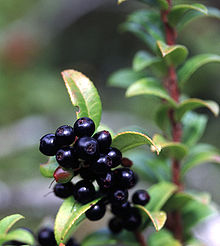Vaccinium ovatum
| Vaccinium ovatum | |
|---|---|
 |
|
| Berry | |
 |
|
| Flower | |
| Scientific classification | |
| Kingdom: | Plantae |
| (unranked): | Angiosperms |
| (unranked): | Eudicots |
| (unranked): | Asterids |
| Order: | Ericales |
| Family: | Ericaceae |
| Genus: | Vaccinium |
| Species: | V. ovatum |
| Binomial name | |
| Vaccinium ovatum Pursh 1813 |
|
Vaccinium ovatum is a North American species of flowering shrub known by the common names evergreen huckleberry, winter huckleberry and California huckleberry.
Contents
Distribution and ecology[edit]
Vaccinium ovatum is a small to medium-sized evergreen shrub native to the Western Pacific Coast of the United States and coastal British Columbia.[1][2][3] Typical flora associates are such plants as the western sword fern (Polystichum munitum), coastal woodfern (Dryopteris arguta), California snowberry (Symphoricarpos mollis), common snowberry (Symphoricarpos albus), and thimbleberry (Rubus parviflorus).[4] Often found sprouting from nurse logs and growing in conjunction with red huckleberry (Vaccinium parvifolium).
Description[edit]
Vaccinium ovatum is a true huckleberry plant, growing well in shade or sun and thriving in acidic soils. Not needing much sun, the plant has a wide variety of forest homes; it is often seen sprouting out of old coast redwood stumps or dense brambles of other forest growths. The shiny, alternately arranged, egg-shaped leaves are 2 to 3 centimeters (0.8-1.2 inches) long and about a centimeter wide (0.4 inches) with finely serrated edges.[5] During the summer the plant produces round, edible black berries up to a centimeter (0.4 inches) in diameter.[6]
Uses[edit]
Culinary[edit]
Traditionally huckleberries were sought after and collected by many Native American tribes[which?] along the Pacific coast in the region.[7]
Cultivation[edit]
Vaccinium ovatum is grown as an ornamental plant for horticultural use by specialty wholesale, retail, and botanic garden native plant nurseries. The plant is successful in natural landscape and native plant palette style, and habitat gardens and public sustainable landscape and restoration projects that are similar to its habitat conditions.[8][9]
See also[edit]
Gallery[edit]
| Wikimedia Commons has media related to Vaccinium ovatum. |
References[edit]
- ^ Biota of North America Program 2014 county distribution map
- ^ Calflora taxon report, University of California, Vaccinium ovatum Pursh, California huckleberry, Huckleberry, evergreen huckleberry
- ^ Turner Photographics, Vaccinium ovatum - Wildflowers of the Pacific Northwest photo, description, partial distribution map
- ^ C. Michael Hogan. 2008. Coastal Woodfern (Dryopteris arguta), GlobalTwitcher, ed. N. Stromberg
- ^ Jepson Manual treatment, University of California — Vaccinium ovatum
- ^ Flora of North America, Vaccinium ovatum Pursh, 1813. California huckleberry
- ^ Foster, Steven; Hobbs, Christopher (April 2002). A Field Guide to Western Medicinal Plants and Herbs. Houghton Mifflin Harcourt. ISBN 039583807X.
- ^ Jepson Horticultural Database for Vaccinium ovatum . 11.10.2010
- ^ CNPLX: Vaccinium ovatum . accessed 11.10.2010
- Stephen Foster and Christopher Hobbs. 2002. Western Medicinal Plants and Herbs (pg. 287). Houghton Miller Company, New York, NY.
External links[edit]
- Calflora Database: Vaccinium ovatum (California huckleberry, evergreen huckleberry)
- Jepson eFlora treatment of Vaccinium ovatum
- United States Department of Agriculture Plants Profile for Vaccinium ovatum
- United States Department of Agriculture, National Forest Service: Vaccinium ovatum
- Vaccinium ovatum — Calphotos Photo gallery, University of California
- Vaccinium
- Berries
- Flora of the West Coast of the United States
- Flora of British Columbia
- Flora of California
- Natural history of the California Coast Ranges
- Natural history of the Peninsular Ranges
- Natural history of the San Francisco Bay Area
- Natural history of the Transverse Ranges
- Plants described in 1813
- Fruits originating in North America
- Plants used in Native American cuisine
- Garden plants of North America
- Bird food plants

